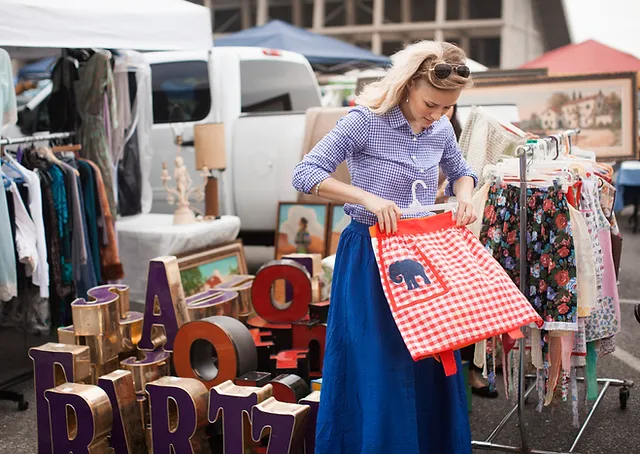
In today’s digital age, entrepreneurs are continually finding new ways to connect with customers and build profitable businesses. One increasingly popular model is the online flea market—a virtual marketplace where unique, vintage, and secondhand goods can be bought and sold. These online spaces capture the nostalgic and eclectic feel of traditional flea markets while offering the benefits of digital accessibility. If you’re looking to start your own online flea market, this guide will walk you through everything you need to know to turn your vision into a thriving business.
Why Start an Online Flea Market?
The idea of flea markets has been around for years. Flea markets, characterized by their mix of old, new, and often quirky items, attract collectors, bargain hunters, and those who appreciate the unusual. In the past, flea markets were physical events, usually held in local areas and during certain times of the year. But with the advent of e-commerce, the flea market model has moved online, opening up new opportunities for entrepreneurs and buyers alike.
Key Benefits of an Online Flea Market
- Geographical Freedom: Unlike a physical flea market, an online marketplace can be accessed by anyone with an internet connection, vastly expanding your potential customer base.
- Curated Experiences: As the market owner, you can tailor your platform to specific niches—whether it’s vintage clothing, handmade crafts, or rare collectibles—attracting like-minded buyers and sellers.
- Always Open: Your market isn’t constrained by location or time, making it accessible to buyers 24/7. This is really important when serving customers around the world in different time zones.
- Lower Overhead Costs: Setting up a website or online marketplace typically has fewer upfront costs than renting a physical location, allowing for greater flexibility and profit margins.
- Custom Branding and Personalization: Unlike listing on third-party marketplaces (like eBay or Etsy), owning your own online flea market allows for complete control over branding, user experience, and marketing strategies.
Simple Ways to Start and Grow a Successful Online Flea Market
Building a thriving online flea market demands thoughtful preparation, effective tools, and consistent dedication.
1. Choose Your Niche
Why a Niche Matters: While a broad flea market might appeal to everyone, it’s harder to stand out in a crowded market. Narrowing down your focus helps attract a specific type of customer who is highly interested in your offerings.
- Popular types of products include old-fashioned clothes, homemade items, rare books, unique home decorations, and collectibles.
- Think about what you enjoy and know a lot about when choosing what to sell—being genuinely interested will make it more fun and feel more real.
2. Conduct Market Research
Understanding your Rival and Consumers is key to success. Look at what other successful online flea markets are doing and identify areas where you can differentiate yourself. Pay close attention to:
- Competitors’ Pricing Strategies: Are they offering free shipping, discounts, or membership perks?
- Customer Preferences: What types of items are selling well? What are common Issues in reviews that you can address?
- Vendor Support: Consider how easy it is for sellers to list their products and how marketplaces handle disputes, shipping, and communication.
3. Build an Engaging and User-Friendly Website
Your website is the base of your online flea market. It needs to be user-friendly, visually appealing, and seamlessly responsive across both desktop and mobile devices.
Essential Features of a Flea Market Website:
- Easy Navigation: Users should be able to browse categories, search for items, and filter results with ease.
- High-Quality Product Listings: Encourage sellers to upload high-quality images and provide detailed descriptions to attract buyers.
- Secure Payment Gateways: Integrate trusted payment options such as PayPal, Stripe, or direct credit card payments to foster trust among users.
- Mobile Optimization: With an increasing number of shoppers using mobile devices, ensure your site is mobile-friendly and responsive.
- Vendor Management Tools: Provide sellers with easy-to-use tools to upload, edit, and manage their listings.

4. Develop a Plan to Draw in Customers
Marketing is critical for growing your online flea market. A strong digital marketing strategy helps you attract both buyers and sellers.
Utilize Social Media
Social platforms like Instagram, Facebook, and Pinterest are ideal for visually showcasing unique items and generating excitement around your marketplace. Post regularly and chat with your followers to build a strong group of supporters.
Search Engine Optimization (SEO)
Optimizing your site for search engines ensures that your market appears in relevant Google searches. Focus on:
- Keywords: Use terms like “vintage items for sale” or “unique collectibles online” throughout your site.
- Meta Tags and Descriptions: Write compelling meta descriptions that include relevant keywords.
- Product Descriptions: Ensure your product pages have detailed descriptions that include important keywords.
Email Marketing
Build an email list of promise buyers and sellers. Regular newsletters can feature new listings, seller spotlights, or exclusive discounts to encourage sales and engagement.
Collaborate with Influencers
Connect with popular personalities in your market to help promote your platform. Whether it’s a popular Instagram personality or a vintage clothing YouTuber, partnering with influencers is a great way to tap into a pre-existing audience.
5. Maximize Profits with Scalable Solutions
Once your flea market is up and running, focus on growth strategies to increase revenue. This includes adding new features, expanding your vendor base, and improving customer retention.
- Offer Subscription Services: Provide a premium membership option for sellers or buyers that comes with exclusive perks such as discounted fees or early access to listings.
- Run Promotions: Use discounts, flash sales, or bundle deals to incentivize purchases and move inventory.
- Track Analytics: Utilize tools like Google Analytics to track site performance, user behavior, and conversion rates, allowing you to make data-driven decisions for future improvements.
Overcoming Common Challenges
Running an online flea market comes with its own set of challenges. Here are some issues and their solutions :
Managing Seller Quality
Ensuring that sellers provide high-quality products and excellent customer service is crucial for maintaining your market’s reputation. Implement a review and rating system that allows buyers to give feedback on their purchases. Additionally, offer a detailed seller guide to help new vendors meet your marketplace standards.
Handling Logistics
Shipping and logistics can become complicated, especially with international sales. Encourage sellers to offer clear shipping policies, and consider integrating shipping calculators or offering flat-rate shipping options to simplify the process.
Competition
With platforms like eBay and Etsy, the competition can be fierce. Differentiate your market by offering a more specialized or curated experience, providing excellent customer service, and creating a loyal community around your niche.
Building Community and Customer Loyalty

Creating a sense of community around your online flea market will help build customer loyalty and encourage repeat sales.
- Forums and Discussion Boards: Implement community forums where users can discuss topics related to your niche, share stories, or exchange tips on collecting or curating items.
- Customer Rewards Programs: Offer loyalty points, referral discounts, or frequent-buyer rewards to keep customers coming back.
- Engagement on Social Media: Continue to engage with customers and sellers on social media and success stories from your marketplace.
Case Studies of Successful Online Flea Markets
Take inspiration from successful online flea markets that have grown by leveraging unique niches and offering exceptional user experiences. Some examples include:
- Chairish: Specializes in vintage furniture and home decor, offering curated collections for design enthusiasts.
- Ruby Lane: Focuses on high-end antiques and collectibles, attracting a loyal community of collectors.
- Depop: Popular among younger audiences, Depop allows users to buy and sell vintage clothing, with a heavy emphasis on social sharing.
These platforms succeeded by focusing on specific niches, offering great customer support, and maintaining a vibrant community.
Conclusion
The future of flea markets is online. With the right tools, a strategic approach, and dedication, your online flea market can become a profitable and engaging space for buyers and sellers alike. Whether you’re interested in vintage goods, collectibles, or handmade crafts, creating a unique marketplace that caters to your passion can lead to entrepreneurial success.
For more interesting Blogs regarding Business and Market Profit visit the link .
FAQs
What are the challenges of running an online flea market? Common challenges include managing seller quality, handling logistics and shipping, and competing with larger platforms like eBay or Etsy.
What is an online flea market? An online flea market is a digital marketplace where people can buy and sell unique, vintage, or secondhand items, similar to a traditional flea market but with the convenience of the internet.
How do I start my own online flea market? Starting an online flea market requires choosing a niche, building a user-friendly website, attracting sellers, and promoting your platform through marketing strategies like social media and SEO.
What products sell best in online flea markets? Popular items include vintage clothing, antiques, collectibles, handmade crafts, and unique home decor.
How do I attract customers to my online flea market? Utilize social media marketing, SEO optimization, email campaigns, and influencer collaborations to attract customers to your platform.







